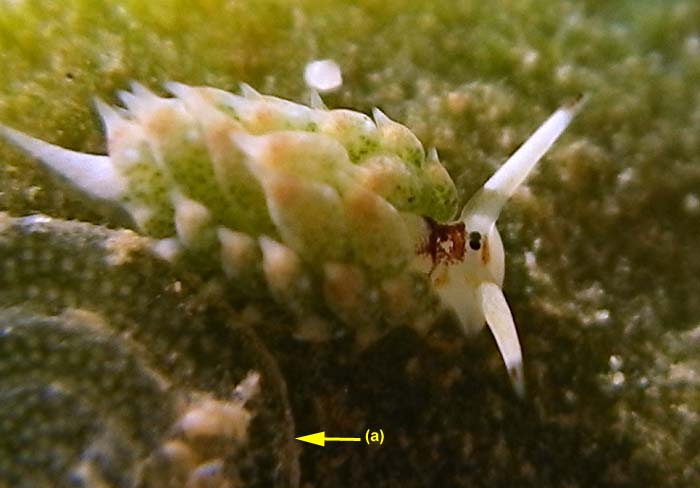This species has been observed on Reunion, Mayotte and Madagascar Islands
Species characteristics : This species has a translucent cream body flecked with white The head has a broad brownish band from the rhinophores to the mouth, and their is a second brown patch from the rhinophores back towards the pericardium. The upper half or the tips of the white rhinophores are black The cerata are transparent, with the green speckled contents showing through the body wall. There is an opaque white cap to the digestive gland just below the translucent tip |

|
|
| Showing species characteristics... | Photo Eva Fontaine |
|
See more about : Sightening and mating periods
See more about : Costasiella kuroshimae variability in Southwest Indian ocean
Remarks :
Identification confirmed by Kathe Jensen and Hsini Lin
Our specimens don't correspond to the Ichikawa original description but Kathe Jensen (personnal communication) and Terry Gosliner (2008) considered that theses kind of specimen as colour variants of C. kuroshimae
Bill Rudman considered that this kind of specimen corresponded to an unsdescribed species Costasiella sp 3 and considered than only specimens corresponded to the Ichikawa original description could be identified to C. kuroshimae...
Synonymous : (according Worms)
- No other name
Bibliographic data :
In the Ichikawa (1993) publication the species is illustrated via a line drawing with a white head having a brown mark medially behind the eyes and a dark streak across the head just in front of the rhinophores. The tips of the white rhinophores were reported to be black and the cerata described as "generally green with white tips".
This species is highly variable in color. We can observed in some specimen
- bright blue spots and/or orange rings or spots on the cerata,
- numerous small dark brown dots on the cerata,
- just a little black streak on the tips of the rhinophores.
- a dark grey-black streak behind the eyes in dorsal midline,
- red or pinkish spots on the dorsal side of the cerata just below the tip,
- black lines extend onto the bases of the rhinophores.
One easy way to recognise species of Costasiella are their eyes. No other group of sacoglossans have their eyes close together in the middle of the head like this.
Found in association with Avrainvillea sp (green algae with a post like "stalk" and a flattened plate-like "leaf") in sandy patches between reefs.
This species looks like Costasiella paweli. But if there are no pedal tentacles (or just short processes of the foot corners), they are Costasiella kuroshimae. However, if there are pedal tentacles it is more likely C. paweli.
This species is similar with Costasiella sp2 by C. kuroshimae differs by :
- The head has a broad brownish band from the rhinophores to the mouth, and their is a second brown patch from the rhinophores back towards the pericardium.
- The upper half or the tips of the white rhinophores are black
Etymology : Ichikawa (1993) chose the specific name for the Japanese name of the island from where the species was collected
References :
Bill Rudman Seaslug site : Sea Slug Forum : Costasiella kuroshimae and Costasiella sp3
Nudipixel Costasiella kuroshimae
Publications :
Ichikawa, M. (1993) Saccoglossa (Opisthobranchia) from the Ryukyu Islands. Publications of the Seto Marine Biological Laboratory, 36 : 119-139
Jensen, K.R. (2007). Biogeography of the Sacoglossa (Mollusca, Opisthobranchia). Bonner Zoologische Beiträge. 55: 255–281.
Other photos of Costasiella kuroshimae :
 |
Philibert Bidgrain Mayotte, mtsanga Guini, less 1 m, 3 August 2010, size : 4-5 mm We can observed in this specimen Found in association with Avrainvillea sp (green algae with a post like "stalk" and a flattened plate-like "leaf") in sandy patches between reefs.
|
Eva Fontaine Mayotte, M'Titi Sada, less 1 m, 30 July 2010, size : 2-3 mm We can observed in this specimen One easy way to recognise species of Costasiella are their eyes. No other group of sacoglossans have their eyes close together (b) in the middle of the head like this. Just a little black streak (c) on the tips of the rhinophores. |
 |
 |
Eva Fontaine Mayotte, M'Titi Sada, less 1 m, 30 July 2010, size : 2-3 mm We can observed in this specimen There are no pedal tentacles (b) (or just short processes of the foot corners), it's a characteristic of Costasiella kuroshimae. Pedal tentacles are present in C. paweli. |
Philibert Bidgrain Mayotte, mtsanga Guini, less 1 m, 7 August 2010, size : 2-3 mm Another specimen with just a little black streak on the tips of the rhinophores. Probably the spawn (a) of this species..There is a similar observation in Gosliner book (2008). |
 |
 |
Eva Fontaine Mayotte, mtsanga Guini, less 1 m, 3 August 2010, size : 4-5 mm A strange specimen without black mark (a) on the rhinophore, but with a brown coloration (b) medialy. |
Fabrice Schubert Mayotte, 10 m, 19 December 2009, size : 5 mm There is an opaque white cap (a) to the digestive gland just below the translucent tip
|
 |
 |
Alain-Benoît Rassat Madagascar, Bosy bé, Sakatia, 2 m, 16 May 2016, size : 6-7 mm
|
Jean Pascal Quod Reunion Coulée 1977 Sainte Rose
|
 |
More photos from Indian Ocean
See more about : Costasiella kuroshimae variability in Southwest Indian ocean
